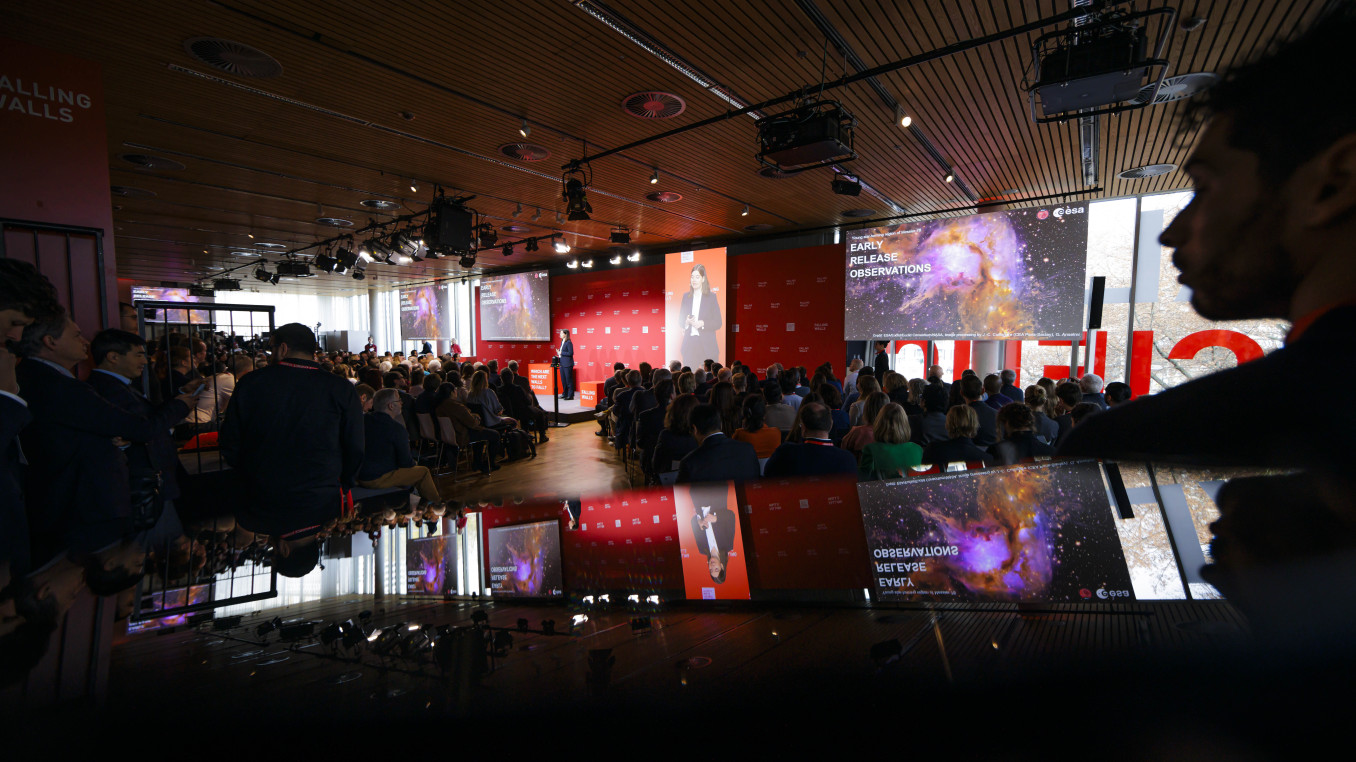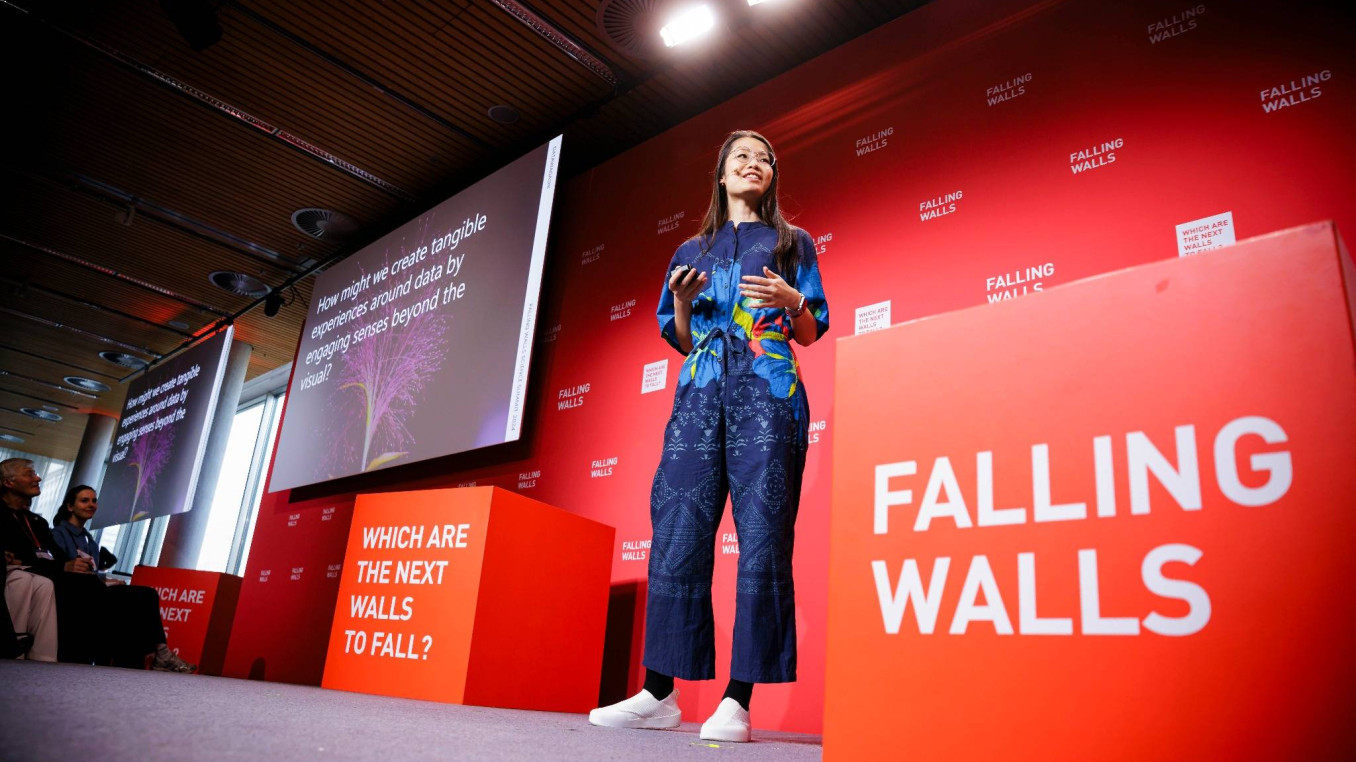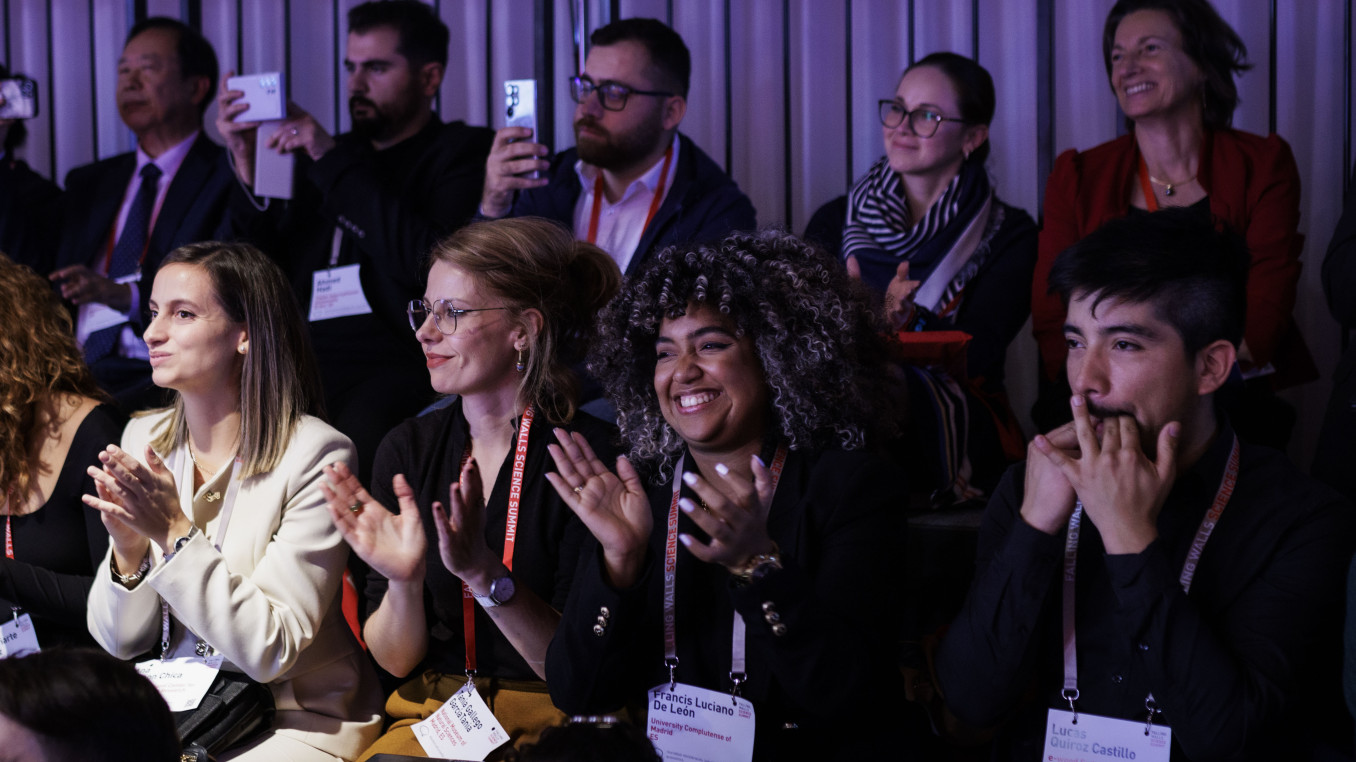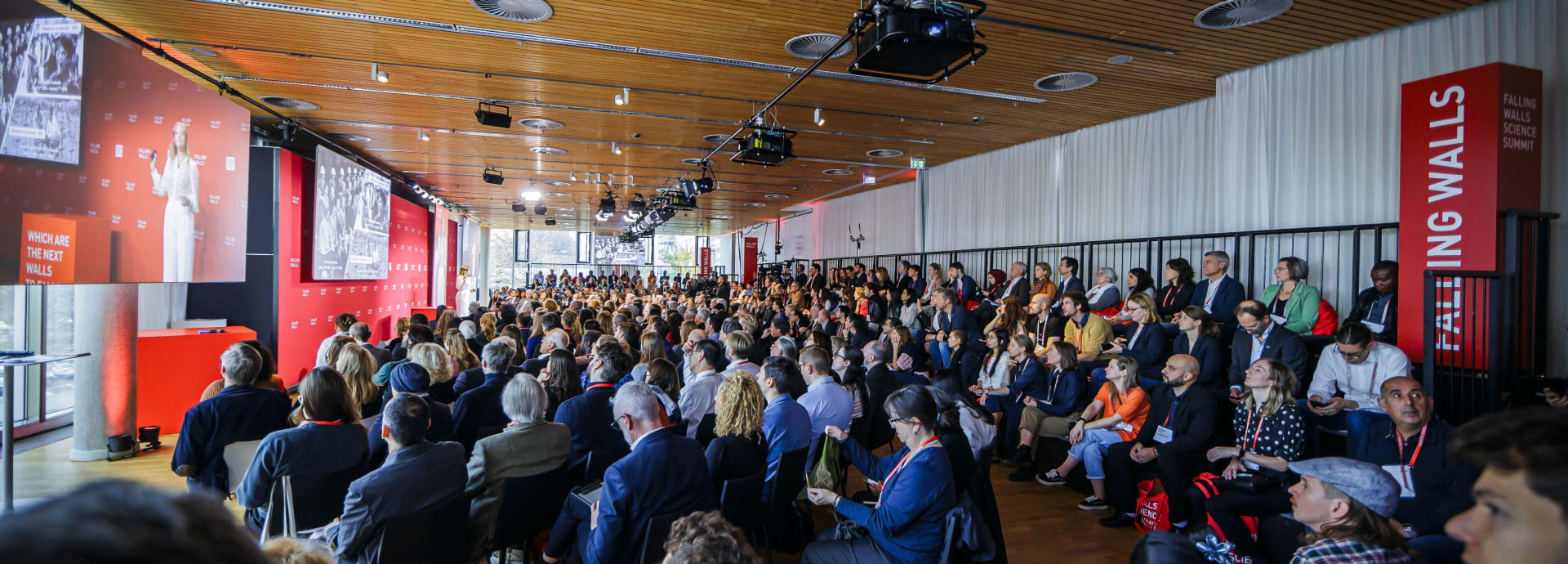
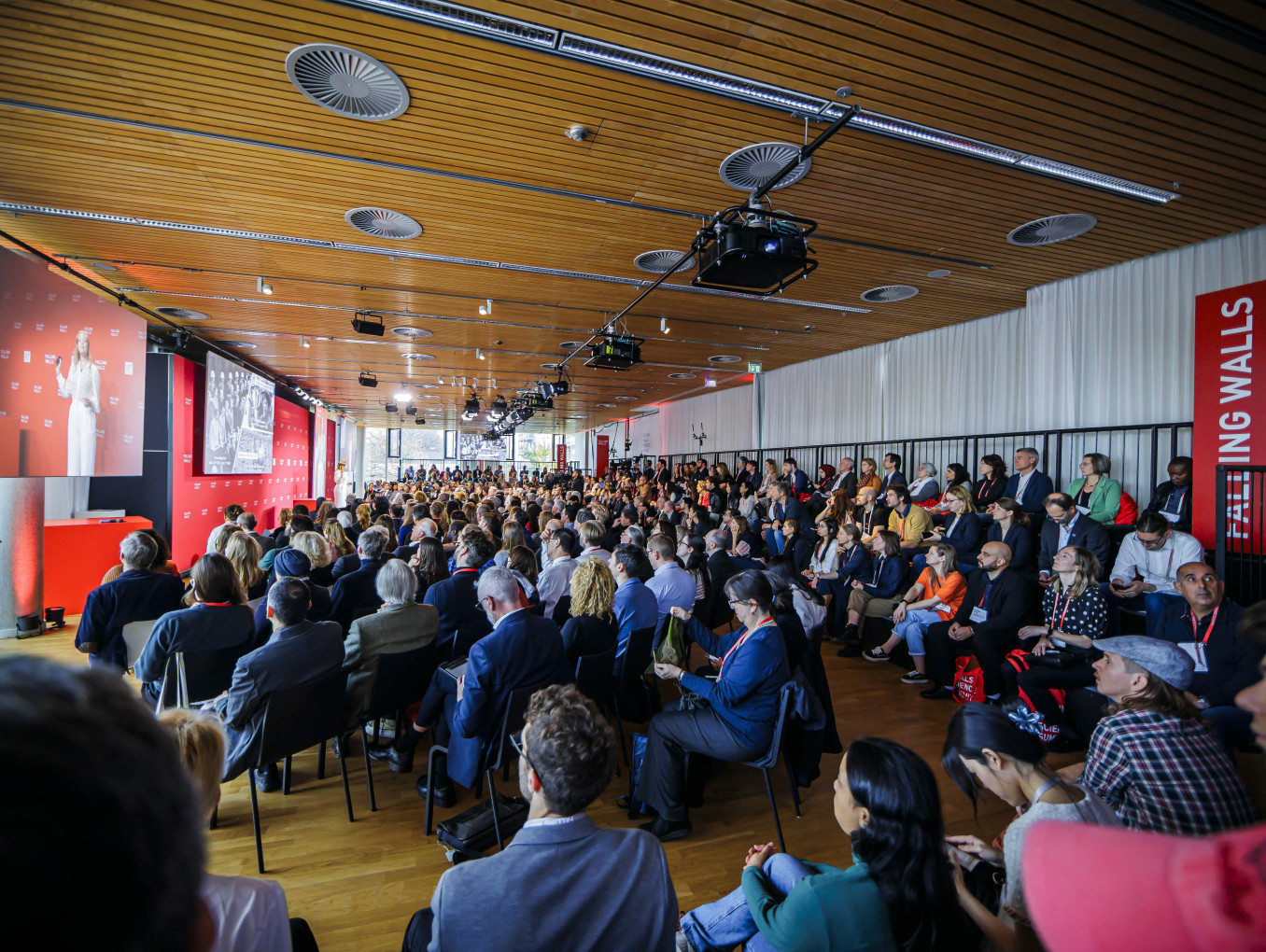
Falling Walls Finalists 2024
Congratulations to all Finalists 2024!
This year's Falling Walls Global Call received more than 1.100 nominations from over 300 different institutions, showcasing innovative scientific advancements and impactful initiatives across various fields.
After the first round of the selection process, we are pleased to announce this year’s finalists. All finalists are one step closer to becoming the Science Breakthrough of the Year, to be celebrated at the Falling Walls Science Summit from 7-9 November 2024 in Berlin.
Next, the juries will evaluate all finalist applications based on the selection criteria and choose the 10 winners, with the exception of the Science Startups and Science Engagement categories. The winners will be announced in mid-August. We are eager to share their inspiring stories of groundbreaking research and ideas with you.
Click on a category below to learn more about the Finalists and their projects.
Meet our Life Sciences Finalists
Ali Maximilian Ertürk, Helmholtz Munich, Breaking the Wall of Animal Use in Research
Andreas Horn, Brigham & Women’s Hospital, Breaking the Wall of Dysfunctional Brain Circuits
Anna Aschenbrenner, Deutsches Zentrum für Neurodegenerative Erkrankungen (DZNE), Breaking the Wall of Precision Medicine
Ariella Shikanov, University of Michigan, Breaking the Wall of Diverse Health Advancements
Ben Black, University of Pennsylvania, Breaking the Wall of Synthetic Human Chromosomes
Benedict Paten, University of California, Santa Cruz, Breaking the Wall of Pangenomics
Cristina Rosell, University of Manitoba, Breaking the Wall of Smart Food Systems
Erich Jarvis, Rockefeller University, Breaking the Wall of Understanding Language
Garry Duffy, University of Galway, Breaking the Wall of Implantable Drug Delivery
Hei Ming Lai, The Chinese University of Hong Kong, Breaking the Wall of 3D Digital Pathology
James McAuley, Neuroscience Research Australia and the University of New South Wales, Breaking the Wall of Chronic Pain
Jan-Wilhelm Kornfeld, University of Southern Denmark, Breaking the Wall of Healthy Fat
Marcel Hövels, University of Bonn, Breaking the Wall of Excessive Sugar Intake
Matthias Lütolf & Francisco Lorenzo Martin, Swiss Federal Institute of Technology Lausanne (EPFL) and Institute of Human Biology (IHB), Breaking the Wall of Lab-Made Mini-Organs
Mengxing Tang, Imperial College London, Breaking the Wall of Heart Vessel Mapping
Michael Platten, German Cancer Research Center, Breaking the Wall of Brain Tumor Vaccines
Michael Fischbach, Stanford University, Breaking the Wall of Commensal Vaccines
Mikhail Kosiborod, Saint Luke’s Health System, Breaking the Wall of Obesity Complications
Montserrat Soler Lopez, European Synchrotron Radiation Facility, Breaking the Wall of Neurodegeneration Onset
Moritz Mall, German Cancer Research Center (DKFZ), Breaking the Wall of Cell Identity Loss
Onur Boyman, University of Zurich, Breaking the Wall of Understanding Long Covid
Paolo Actis, University of Leeds, Breaking the Wall of Cancer Therapy Resistance
Rana Dajani, The Hashemite University, Breaking the Wall of Epigenetic Violence
Ronit Freeman, University of North Carolina - Chapel Hill, Breaking the Wall of Synthetic Cells
Rory Henderson, Duke University, Breaking the Wall of Developing an HIV-1 Vaccine
Stephanie Fraley, University of California San Diego, Breaking the Wall of Sepsis
Stephen O’Rahilly & Marlena Fejzo, University of Cambridge & University of Southern California, Breaking the Wall of Pregnancy Sickness
Tam Mignot, CNRS-Aix Marseille University, Breaking the Wall of Soil Revitalization
Wenning Qin, eGenesis, Breaking the Wall of Sustainable Organ Supply
Xenofon Strakosas, Linkoping University, Breaking the Wall of Bio-Electronics
Meet our Physical Sciences Finalists
Adam Frank, University of Rochester, Breaking the Wall of Oxygen and Alien Life
Boaz Lubotzky, Hebrew University of Jerusalem (huji), Breaking the Wall of Quantum Chip Photonics
Carlos Frenk, Institute for Computational Cosmology, Breaking the Wall of Cosmological Simulations
Daniel Shu Ping Lau, The Hong Kong Polytechnic University, Breaking the Wall of Ferroelectric Transistors
Dmitry Budker, James Eills & Danila Barskiy, Helmholtz Institute (GSI) Mainz & Johannes Gutenberg University, Breaking the Wall of Field Dependency in NMR
Eva Zurek, University at Buffalo, State University of New York, Breaking the Wall of Extreme Chemistry
Ewold Verhagen, AMOLF, Breaking the Wall of Programmable Metamaterials
Giulia Galli, University of Chicago, Breaking the Wall of Quantum Materials
Günther Rupprechter, Institute of Materials Chemistry, TU Wien, Breaking the Wall of Green Photopaint
Isabelle Cantat, Université de Rennes - Institut de Physique de Rennes, Breaking the Wall of Foam Rheology
Jan Rothhardt, Helmholtz Institute Jena, Breaking the Wall of Table-Top EUV Microscopy
Jason Twamley, Okinawa Institute of Science and Technology, Breaking the Wall of Gravity-Free Technology
Javier Garcia Martinez, University of Alicante, Breaking the Wall of Nanostructured Catalysts
Jeff Dahn, Dalhousie University, Breaking the Wall of Battery Lifetime
Jennifer Rupp, Technical University Munich (TUM) Germany, Breaking the Wall of Green Energy Conversion
Liang Jie Wong, Nanyang Technological University, Breaking the Wall of Quantum X-ray Tech
Mark Levin, University of Chicago, Breaking the Wall of Molecular Editing
Martin Zwierlein, Massachusetts Institute of Technology, Breaking the Wall of Complex Quantum Matter
Nils Johan Engelsen, Chalmers Institute of Technology, Breaking the Wall of Quantum Drum Vibrations
Päivi Törmä, Aalto University, Breaking the Wall of Ambient Superconductivity
Peter Richard Schreiner, Justus Liebig University, Breaking the Wall of Quantum Reaction Control
Puneet Anantha Murthy, ETH Zürich, Breaking the Wall of Scalable Quantum Dots
Quan Li, The Chinese University of Hong Kong, Breaking the Wall of Nanoscale Mechanical Sensing
Richard Curry, University of Manchester, Breaking the Wall of Quantum Silicon
Richard Town, Lawrence Livermore National Laboratory, Breaking the Wall of Fusion Gain
Saw Wai Hla, Ohio University and Argonne National Laboratory, Breaking the Wall of 128 Years X-ray History
Simon Storz, ETH Zürich, Breaking the Wall of Quantum Communication
Siye Ding, General Atomics, Breaking the Wall of Efficient Fusion Power
Thorsten Schumm & Ekkehard Peik, Vienna University of Technology / TU Wien & PTB Germany, Breaking the Wall of Light-Matter Interaction
Xiaogang Liu, National University of Singapore, Breaking the Wall of X-ray Imaging
You want to learn more about the Physical Sciences category? Click on the button below.
Meet our Engineering & Technology Finalists
Abeed Sarker, Emory University, Breaking the Wall of Substance Use Stigma
Andreas Güntner, ETH Zürich, Breaking the Wall of Electronic Scent Detection
Burak Ozdoganlar, Carnegie Mellon University, Breaking the Wall of Organ Engineering
Canan Dagdeviren, Massachusetts Institute of Technology, Breaking the Wall of Breast Cancer Detection
Christian Weilach, TU Wien, Breaking the Wall of Green Chemistry Revolution
Chwee Teck Lim, National University of Singapore, Breaking the Wall of Realistic Digital Healthcare
Franck Ruffier, CNRS, Breaking the Wall of Bio-Inspired Robotics
Gang Li, The Hong Kong Polytechnic University, Breaking the Wall of Inefficient Solar Cells
Guihua Yu, University of Texas at Austin, Breaking the Wall of Solar Water Sustainability
Havid Aqoma Khoiruddin, Xiamen University Malaysia, Breaking the Wall of High-Efficiency Quantum Solar
Hervé Lissek, Ecole Polytechnique Fédérale de Lausanne, Breaking the Wall of Noise for a Quieter Life
Ian Nicholls, Linnaeus University, Breaking the Wall of Electronic Waste
Ivan Moreno-Hernandez, Duke University, Breaking the Wall of Atomic-Scale Dynamics
Iwan Hächler, ETH Zürich, Breaking the Wall of Foggy Glasses
Jeehwan Kim, Massachusetts Institute of Technology, Breaking the Wall of Semiconductor 3D Integration
Johannes Schmude, IBM, Breaking the Wall Between AI and HPC
Luis Fernando Velásquez-García, Massachusetts Institute of Technology, Breaking the Wall of 3D-Printed Magnetic Systems
Mennatallah El-Assady, ETH Zürich, Breaking the Wall of LLM Insight and Reliability
Sang-Hoon Bae, Washington University, Breaking the Wall of Energy Density Limits
Sang-Woo Kim, Yonsei University, Breaking the Wall of Ultrasound Energy Harvesting
Sandrine Blazy, University of Rennes - CNRS IRISA, Breaking the Wall of Bug-Free Software
Solaiman Shokur, CHUV: Centre hospitalier universitaire vaudois, Breaking the Wall of Thermal Sensations in Amputees
Sourabh Saha, Georgia Institute of Technology, Breaking the Wall of Nanoscale Metal Printing
Tianyi Ma, RMIT University, Breaking the Wall of Limited Solar Energy Utilisation
Wael Jaafar, École de technologie supérieure (ETS), University of Quebec, Breaking the Wall of Dangerous Roads
Walter de Heer, Georgia Institute of Technology, Breaking the Wall of Moore's Law
Yanhui Chu, South China University of Technology, Breaking the Wall of Advanced Thermal Materials
Xin Li, Harvard University, Breaking the Wall of Solid-State Battery Innovation
Xin Zhang, Boston University, Breaking the Wall of Metamaterial-Enhanced MRI
Yang Chai, The Hong Kong Polytechnic University, Breaking the Wall of Efficient Sensory AI Systems
You want to learn more about the Engineering & Technology category? Click on the button below.
Meet our Social Sciences & Humanities Finalists
Albert Nyarko-Agyei, University of Nottingham, Breaking the Wall of Hidden Population Estimates
Anatole Boute, The Chinese University of Hong Kong, Breaking the Wall of Energy Dependence
Catherine Ward, University of Cape Town, Breaking the Wall of Global Parenting Support
Clara Mattei, New School for Social Research, Breaking the Wall of Postwar Capitalism History
Chikako Ozawa-De Silva, Emory University, Breaking the Wall of Combating Loneliness
Christian Leuz, University of Chicago, Breaking the Wall of Intransparent Fracking Practices
Emmanuel Quarshie, University of Ghana, Breaking the Wall of Adolescent Mental Health
Florian Zimmermann, IZA and University of Bonn, Breaking the Wall of Climate Change Denial
Harvey Whitehouse, University of Oxford, Breaking the Wall of Climate Psychology
Gildas Bregain, National Centre for Scientific Research (CNRS), Breaking the Wall of Disability Rights History
Jennifer Llewellyn, Dalhousie University, Breaking the Wall of Transformative Justice
Jon Roozenbeek, King’s College London, Breaking the Wall of Propaganda
Kimberly Doell, University of Vienna, Breaking the Wall of Climate Psychology
Lingfei Wu, University of Pittsburgh, Breaking the Wall of Team Innovation
Maximilian Schich, Tallinn University, Breaking the Wall of Cultural Data Analytics
Michael Bruter, London School of Economics and Political Science (Electoral Psychology Observatory), Breaking the Wall of Democratic Exclusion
Michael Johnson, University of Washington, Breaking the Wall of Better Group Decisions
Nathan Congdon, Queen’s University Belfast and Orbis International, Breaking the Wall of Vision-Driven Development
Oriel Feldman Hall, Brown University, Breaking the Wall of Political Polarization
Petra Ahrweiler, TISSS Lab, Johannes Gutenberg University Mainz, Breaking the Wall of AI in Public Services
Peter F. Titzmann, Leibniz University Hannover, Breaking the Wall of Immigrant Youth Adaptation
Rafael Prieto-Curiel, Complexity Science Hub, Breaking the Wall of Drug Cartel Analysis
Rafael Yuste, Columbia University, Breaking the Wall of Neurorights Protection
Romina Rekers, FLACSO/Fundación Ética Climática y Desarrollo/University of Graz, Breaking the Wall of Climate-Health Ethics
Russell Funk, University of Minnesota, Carlson School of Management, Breaking the Wall of the Endless Frontier
Tobias Brandner, Chinese University of Hong Kong, Breaking the Wall of Prisoners' Social Exclusion
Tracie Afifi, University of Manitoba, Breaking the Wall of Child Protection
Victor Gysembergh, National Centre for Scientific Research (CNRS), Breaking the Wall of Manuscript Restoration
Yaw Nyarko, New York University, Breaking the Wall of Rural Commodity Market Access
Yu Xiong, University of Surrey, Breaking the Wall of Blockchain and Emissions
You want to learn more about the Social Sciences & Humanities category? Click on the button below.
Meet our Art & Science Finalists
Anna Dumitriu, Institute of Epigenetics and Stem Cells, Helmholtz Zentrum München, Breaking the Wall of Cell Memory
Anna Vershinina & Wieger Wamelink, KU Leuven & Wageningen University, Breaking the Wall of 3D-Printed Eco-Habitats
Amanda Lee Falkenberg, The Moons Symphony, Breaking the Wall of Space Exploration
Andrea Conte, Climate art Project - Niche, University Ca’Foscari - andreco studio - Futurecologies srl, Breaking the Wall of Climate Injustice
Briony Barr, The University of Melbourne, Breaking the Wall of Modelling Systems Through Art
Clare Nattress, York St John University, Breaking the Wall of Air Pollution
Deidre Cavazzi, Saddleback College, Breaking the Wall of Neuroscience Dance Theatre
Egór Kraft, University of Art & Design Linz, AT, Breaking the Wall of Disinformation
Fara Peluso, Staatliche Hochschule für Gestaltung Karlsruhe (HfG), Breaking the Wall of Sustainable Sound Art
Gérard Assayag, IRCAM (Institut de recherche et coordination acoustique/musique), Breaking the Wall of AI Musical Co-Creativity
Gregory Darcy, DieTanzKompanie, Breaking the Wall of Exclusion
Guy Ben-Ary & Nathan Thompson, SymbioticA, University of Western Australia, Breaking the Wall of In-Vitro Intelligent Agents
Hiroto Nagai, Rissho University, Breaking the Wall of Music from Earth Data
Ivan Abreu Ochoa & Malitzin Cortes, Centro de Diseño, Cine y Television, Breaking the Wall of Informal Architecture
Julia Janssen, Studio Julia Janssen, Breaking the Wall of Digital Heteronomy
Kat Austen, Studio Austen, Breaking the Wall of Plastic-Tree Coexistence
Laura Cinti, Winchester School of Art, University of Southampton, Breaking the Wall of Cycad Extinction
Marcos Lutyens, Independent artist, Breaking the Wall of Reclaimed Oil Rigs
Martin Hennecke, Saarland State Theater, Breaking the Wall of Audience Interaction
Naila Kuhlmann, McGill University, Breaking the Wall of the Ivory Tower with Art
Philip Samartzis, RMIT University, Breaking the Wall of Immersive Sound Art
Rhodnie Désir, RD Créations, Breaking the Wall of the Human Heart
Sarah Nance, Binghamton University, State University of New York, Breaking the Wall of Climate Data Sonification
Teppei Katori, King’s College London, Breaking the Wall of Cosmic Ray Immersion
Tiange Wang, VLab, Breaking the Wall of Multisensory Data
Tim Otto Roth, studio imachination labs, Breaking the Wall of a Neuronal Sonic Theatre
Rashaad Newsome, Rashaad Newsome Studio, Breaking the Wall of Traditional Education
Refik Anadol, Refik Anadol Studio (RAS) and University of California, Los Angeles (UCLA), Breaking the Wall of Museum Metadata: AI Artistry
Robertina Šebjanič, Robertina Šebjanič Studio, Breaking the Wall of Aquatic Sensing
Yuning Chen, Design Informatics, University of Edinburgh, Breaking the Wall of Mechanistic Views of Life
You want to learn more about the Art & Science category? Click on the button below.
Meet our Science Engagement Finalists
Abdul Karim Sesay, Sierra Leone, Altruistech Creativity Hub
Amna Lal Hussain, Pakistan, Lahore Science Mela (LSM)
Anna-Sophie Jürgens, Australia, The Popsicule - The Science in Popular Culture and Entertainment Hub
Apple Pui Yi Chui, Hong Kong, School Coral Nursery Programme: Promoting Awareness and Coral Stewardship
Bengisu Berispek, Germany, Breaking the wall of Climate & SDG Education for Berlin schools and universities- Sustain.ALL
Cecilia Manosa Nyblon, United Arab Emirates, We Are The Possible
Charles Umeh, Nigeria, Parkers Resilient Health
Chuck Chuan Ng, Malaysia, Vet-BioR
Dilip Surkar, India, Making Schools STEM-able
Frankline Ojiambo, Kenya, Empowering a sustainable future through tech education and responsible waste management
Geraint Rhys Whittaker, Germany, Ocean Science Jam
Hassan Farah, United States of America, Our Future Is Science
Jane Yau, Germany, Games Realising Effective and Affective Transformation
Josefa Gonzalez, Spain, Melanogaster: Catch The Fly!
Joy Offere, Nigeria, Shenovate
Kakani Katija, United States of America, FathomVerse: Explore the Depths
Kaylene Cooper, Australia, Wonder of Science
Lennox Omondi, Kenya, EcoBana
Lucy Brown, United Kingdom, Refugia: Co-designing a creative and equitable engagement programme for wildlife conservation science with refugee and asylum seekers
María Cristina Díaz Velázquez, Colombia, CiuLab Bogotá, city and civic culture lab
Melissa Jackson, Australia, iKnow weKnow - Co-Designing a Resilient Water and Energy Community Toolbox
Nkosana Masuku, Zimbabwe, STEM Sustainability and Climate Adaptation Initiative
Oriana Trejo Alvarez, Mexico, Communication of Knowledge Directorship - Autonomous Metropolitan University
Oris Chimphambano, Malawi, SCIENCE FOR ALL (SCI4O)
Otuo-Akyampong Boakye, Ghana, Teens-for-STEM
Pauline Münch, Germany, AnthropoScenes
Rita Otu, Nigeria, RADIO FOR RESILIENCE: BREAKING THE WALLS TO CLIMATE CHANGE
Sandra Roberts, United States of America, Down To Earth
Sara Verstraeten, Germany, TREC Public Engagement
Stanley Anigbogu, Nigeria, AVATAR STATION
You want to learn more about the Science Engagement category? Click on the button below.
Meet our Science Start-up Finalists
3DBioFibR, Canada
AATec Medical GmbH, Germany
ActiTrexx, Germany
AdaptX Systems, Germany
AdRegeneer, Switzerland
Adsorbi AB, Sweden
AI PROTEINS, United States of America
aisencia GmbH, Germany
Aixima GmbH, Germany
AK-Sens, Saudi Arabia
Allegrow Biotech, Hong Kong
Amalus Therapeutics, Belgium
Amun AI, Sweden
Anzen Walls, United Kingdom
Aquit, Chile
ARQUE Systems, Germany
ATLyphe, Switzerland
Avatar MedTech, Argentina
Bac3Gel LDA, Portugal
Batiprint 3D, France
Bioeutectics, Argentina
Bitrobius Genetics, United Kingdom
Blue Filter, Palestine, State of
Carbon Mobile GmbH, Germany
CareGlance, Italy
CinSOIL, Germany
Clean Ocean Coatings, Germany
CompreVie, Austria
Cyclize GmbH, Germany
Daisy Lab, New Zealand
Deco Labs Inc., United States of America
DeepEn, Germany
DeepLeaf, Morocco
DermR Health Solutions, Australia
DNA Switch, Italy
Dunia, Germany
eco:fibr, Germany
ecolocked, Germany
ElectraLith, Australia
Elle, MD Biotechnologies, Canada
Elzian Agro (Privet) Limited, Sri Lanka
EVIIVE, Switzerland
Exaia Technologies, Germany
Exazyme, Germany
ExoMas S.A, Argentina
Factor4Solutions GmbH, Germany
Fattastic, Singapore
Fluorobiotech, South Africa
ForestGuard, Turkey
Fungi Life, Colombia
Gameet, Argentina
Gisens, Argentina
Greenlyte Carbon Technologies, Germany
Hayat Technology, Tunisia
Hormony, Singapore
Hyphen Global AG, Switzerland
InPlanet, Germany
ionysis GmbH, Germany
Izagri, Tunisia
LaSense Technology Limited, Hong Kong
Nanoflex Robotics, Switzerland
Nanolope PCM, Germany
Nanosene, South Africa
Level Nine, Germany
Lightly Technologies, Czech Republic
LigniLabs, Germany
Linium Biochemicals, France
Mimi-Q GmbH, Germany
MobyFly, Switzerland
Nano24, Israel
Nanofacile, Canada
Nanotransfer, Argentina
Nat4Bio, Argentina
NextAV, Tunisia
NOSI - Network for Olfactory System Intelligence GmbH, Austria
Not Fossil, Argentina
NutriSen, Germany
Ocular BioDesign, Mexico
Origin by Ocean, Finland
Parastruct, Austria
PBF NUTRIENTES, Brazil
Pearcode, France
Phaeosynt, Germany
phelas, Germany
PILL.AR, Argentina
PolymerActive, Germany
PolyPloy, Germany
PRAMOMOLECULAR GmbH, Germany
qCoat GmbH, Germany
Qkera, Germany
QT Sense, Netherlands
RayVen, Germany
re.solution GmbH, Germany
Recolony AG, Switzerland
REME-D, Egypt
Revyn Medical, Canada
Robocare, Tunisia
S.Lab, Ukraine
Seamless Energy Technologies GmbH, Germany
Sinopsis Software Technologies, Turkey
SkySpec, Japan
Solaires Entreprises Inc, Canada
Spark e-Fuels, Germany
Sparxell, United Kingdom
Sphere Bio, Argentina
Sylvarum, United States of America
Tau Systems Inc, United States of America
theblood, Germany
Tunisia Baits, Tunisia
VivArt-X, Netherlands
VYLD, Germany
xemX materials space exploration GmbH, Germany
Xinterra, Singapore
Xylogic, Australia
Zeuron.ai, India
You want to learn more about the Science Start-Ups category? Click on the button below.
MEET OUR WOMEN’S IMPACT AWARD FINALISTS
Adeline Lacroix, Université Grenoble Alpes
Amy Whitbread, The smart period blood GmbH
Antonia Saktiawati, Center for Tropical Medicine, Faculty of Medicine, Public Health, and Nursing, Universitas Gadjah Mada
Inge Katrin Herrmann, University of Zurich
Katrin Lammers, Reiner Lemoine Institut
Marianna Prokopi-Demetriades, RSL Revolutionary Labs Ltd, Theramir Ltd, Promed Bioscience Ltd
Valerie Makoge, Institute of Medical Research and Medicinal Plants Studies
